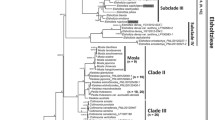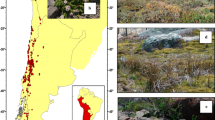Abstract
Daphne (Thymelaeaceae) is a small group of shrubby plants mainly distributed in subtropical and temperate regions of the world with a few species also occurring in alpine habitats. Of ca. 95 species in the world, six species and one variety are reported from India. Phylogenetic relationships of the Indian Daphne were investigated based on nuclear (ITS) and plastid (rbcL and trnL-F) regions. A total of 21 sequences representing five taxa of the six species reported from India were newly generated for the present study. The phylogenies using ML and Bayesian analyses obtained from individual and combined datasets were congruent and strongly supported the monophyly of the genus Daphne. Combined analyses revealed two major well-supported clades. The systematic relationship of the narrow endemic species, D. thanguensis was also confirmed as sister to the morphologically similar D. tangutica. The study supports the independent species status of D. retusa and D. tangutica. Ancestral state reconstructions were done using two major features, viz. presence or absence of indumentum on calyx and colour of the calyx occurrence of species. A taxonomic key has also been provided for the Indian taxa. This is the first comprehensive molecular study on the Indian Daphne.







Similar content being viewed by others
References
Albert VA, Williams SE, Chase MW (1992) Carnivorous plants: Phylogeny and structural evolution. Science 257:1491–1495. https://doi.org/10.1126/science.1523408
Alonso C, Herrera C (2011) Back-and-forth hermaphroditism: phylogenetic context of the reproductive system evolution in sub-dioecious Daphne laureola. Evolution 65:1680–1692. https://doi.org/10.1111/j.1558-5646.2011.01246.x
Alverson WS, Karol KG, Baum DAY, Chase MW, Swensen SM, Court R, Sytsma KY (1998) Circumscription of the Malvales and relationships to other Rosidae: evidence from rbcL sequence data. American J Bot 85:876–887. https://doi.org/10.2307/2446423
Bakker FT, Helbrugge D, Culham A, Gibby M (1998) Phylogenetic relationships within the Pelargonium sect. Peristera (Geraniaceae) inferred from nrDNA and cpDNA comparisons. Plant Syst Evol 211:273–287. https://doi.org/10.1007/BF00985364
Baldwin BG, Sanderson MJ, Porter JM, Wojciechowski MF, Campbell CS, Donoghue MJ (1995) The ITS region of nuclear ribosomal DNA: A valuable source of evidence on angiosperm phylogeny. Ann Mo Bot Gard 82:247–277. https://doi.org/10.2307/2399880
CBOL Plant Working Group (2009) A DNA barcode for land plants. Proc Natl Acad Sci 106:12794–12797
Darriba D, Taboada GL, Doallo R, Posada D (2012) jModel Test 2: more models, new heuristics and parallel computing. Nat Methods 9:772. https://doi.org/10.1038/nmeth.2109
Ghosh DK, Mallick JK (2014) Flora of Darjeeling Himalaya and foothills (Angiosperms). Research Circle, Forest Directorate Government of West Bengal & Bishen Singh Mahendra Pal Singh, pp 542–543
Ghosh J, Midday M, Dey SK, Maity D (2018) Daphne thanguensis sp. nov. (Thymelaeaceae) from Sikkim Himalaya. Nord J Bot 36:1–5. https://doi.org/10.1111/njb.01714
Govaerts R (2000) World Checklist of Seed Plants Database in ACCESS D: 1–30141
Halda JJ (1998) Some taxonomic problems in the genus Daphne L. Acta Mus Richnov Sect Nat 5:133–160
Halda JJ (2001) The genus Daphne. SEN, Dobré
Herbada D (2006) Origin and diversification of Thymelaea (Thymelaeaceae): inferences from a phylogenetic study based on ITS (rDNA) sequences. Pl Syst Evo 257:159–187. https://doi.org/10.1007/s00606-005-0371-z
Holubec V, Svobodová LL (2020) Morphological and molecular status of Daphne wolongensis C.D.Brickell et B.Mathew as genetic resource for horticulture. Agronomy 10(11):1–15. https://doi.org/10.3390/agronomy10111628
Huelsenbeck JP, Crandall KA (1997) Phylogeny estimation and hypothesis testing using maximum likelihood. Annu Rev Ecol Syst 28:437–466. https://doi.org/10.1146/annurev.ecolsys.28.1.437
Jeyarani JN, Yohannan R, Vijayavalli D, Dwivedi MD, Pandey AK (2018) Phylogenetic analysis and evolution of morphological characters in the genus Jasminum L. (Oleaceae) in India. J Genet 97:1225–1239. https://doi.org/10.1007/s12041-018-1019-4
Johnson LA, Soltis DE (1994) matK DNA sequence and phylogenetic reconstruction in Saxifragaceae s.s. Syst Bot 19:143–156. https://doi.org/10.2307/2419718
Katoh K, Standley DM (2013) MAFFT multiple sequence alignment software version 7: improvements in performance and usability. Mol Biol Evol 30(4):772–780. https://doi.org/10.1093/molbev/mst010
Khadgi N (2011) Resource assessment of Daphne bholua in Bhujung VDC of Annapurna Conservation Area, Central Nepal. Tribhuvan University (M.Sc. dissertation)
Körner C (2016) Plant adaptation to cold climates [version 1; referees: 2 approved]. F1000Research 5(F1000 Faculty Rev):2769. https://doi.org/10.12688/f1000research.9107.1
Kress WJ, Erickson DL (2007) A two-locus global DNA barcode for land plants: The coding rbcL gene complements the non-coding psbA-trnH spacer region. PLoS ONE 2(6):e508. https://doi.org/10.1371/journal.pone.0000508
Kuzmina ML, Braukmann TWA, Fazekas AJ, Graham SW, Dewaard SL, Rodrigues A, Bennett BA, Dickinson TA, Saarela JM, Catling PM, Newmaster SG, Percy DM, Fenneman E, Lauron-Moreau A, Ford B, Gillespie L, Subramanyam R, Whitton J, Jennings L, Metsger D, Warne CP, Brown A, Sears E, Dewaard JR, Zakharov EV, Hebert PDN (2017) Using herbarium-derived DNAs to assemble a large scale DNA barcode library for the Vascular Plants of Canada. Appl Plant Sci 5:1700079. https://doi.org/10.3732/apps.1700079
Lee SY, XuKe-W, Huang C-Y, Lee J-H, Liao WB, Zhang YH, Fan Q (2021) Molecular phylogenetic analyses based on the complete plastid genomes and nuclear sequences reveal Daphne (Thymelaeaceae) to be non-monophyletic as current circumscription. Plant Diversity (In Press) https://www.sciencedirect.com/science/article/pii/S2468265921001311
Mabberley DJ (2017) Mabberley’s plant–book, A portable dictionary of plants, their classification and uses, 4th edn. Cambridge University Press, Cambridge, p 276
Maddison WP, Maddison DR (2015) Mesquite: a modular system for evolutionary analysis. Mesquite v.3.40 See http://mesquiteproject.org
Mahanta D, Tiwari SC (2005) Natural dye-yielding plants and indigenous knowledge on dye preparation in Arunachal Pradesh, northeast India. Curr Sci 88(9):1474–1480
Miller MA, Pfeiffer W, Schwartz T, (2010) The CIPRES science gateway. In Proceedings of the Gateway Computing Environments Workshop (GCE), New Orleans, LA. ACM Press, New York, pp 1–8
Pecnikar ZF, Fujs N, Brus R, Ballian D, Buzan E (2017) Insights into the plastid diversity of Daphne blagayanaFreyer (Thymelaeaceae). J Syst Evol 9999(999). DOI: https://doi.org/10.1111/jse.12245
Peterson PM, Romaschenko K, Herrera Arrieta Y, Saarela J (2014) A molecular phylogeny and new subgeneric classification of Sporobolus (Poaceae: Chloridoideae: Sporobolinae). Taxon 63:1212–1243. https://doi.org/10.12705/636.19
Rae SJ (1999) Thymelaeaceae. In: Grierson AJC, Long DG (eds) Flora of Bhutan, vol 2. Royal Botanic Garden, Edinburgh, pp 208–213
Sinha BK, Dash SS, Singh P (2019) Plants of Indian Himalayan Region: an annotated checklist & pictorial guide. Part II. Botanical Survey of India, Kolkata, pp 618–619
Smith WW, Cave GH (1913) A note on the Himalayan species of Daphne. Rec Bot Surv India 6:45–54
Stamatakis A (2014) RAxML version 8: A tool for phylogenetic analysis and post-analysis of large phylogenies. Bioinformatics 30:1312–1313. https://doi.org/10.1093/bioinformatics/btu033
Taberlet P, Gielly L, Pautou G, Bouvet J (1991) Universal primers for amplification of three non-coding regions of chloroplast DNA. Plant Mol Biol 17:1105–1109. https://doi.org/10.1007/BF00037152
Van der Bank M, Fay MF, Chase MW (2002) Molecular phylogenetics of Thymelaeaceae with particular reference to African and Australian genera. Taxon 51:329–339. https://doi.org/10.2307/1554901
Wang Y et al (2007) Daphne L. In: Wu Z-Y, Raven PH (eds) Flora of China, vol 13. Science Press; Miss. Bot. Gard. Press, pp 230–245
White TJ, Burns T, Lee S, Taylor J (1990) Amplification and sequencing of fungal ribosomal RNA genes for phylogenetics. In: Innis MA, Gelfand DH, Sninsky JJ, White TJ (eds) PCR protocols A guide to methods and applications. Academic Press, San Diego (California), pp 315–322
Acknowledgements
We are thankful to the Ministry of Environment, Forest and Climate Change, Govt. of India for financial support [NMHS/2015-16/LG-05; 22018/13/2015-RE(Tax)&GBPNI/ NMHS 2017 2018/LG 03/570 /26/02/2018]. The Department of Forests, Environment and Wildlife Management, Govt. of Sikkim and Superintendent of Police, Gangtokare warmly thanked for permitting and supporting our field visits. Authors are thankful to the Director, Botanical Survey of India, Kolkata and the Director, Zoological Survey of India Kolkata for facilities and the State Forest Department, Govt. of West Bengal for permitting field surveys. We thank Dr. Katarína Hegedüšová Vantarová, Managing Editor, Biologia, for his guidance during revision of the manuscript and Dr. Jaybert Arellado, JEO Assistant, Biologia for his constant support. We are also grateful to two reviewers for their constructive comments on our manuscript.
Author information
Authors and Affiliations
Corresponding authors
Ethics declarations
Ethical statement
The authors comply with all rules of the journal following the COPE guidelines; all authors have contributed to and approved the final manuscript.
Conflict of interest
The authors declare that they have no conflict of interest.
Additional information
Publisher's note
Springer Nature remains neutral with regard to jurisdictional claims in published maps and institutional affiliations.
Rights and permissions
About this article
Cite this article
Banerjee, A., Dwivedi, M.D., Kasana, S. et al. Phylogenetic relationships in Indian Daphne (Thymelaeaceae) based on nuclear ITS and cpDNAdata. Biologia 77, 3071–3086 (2022). https://doi.org/10.1007/s11756-022-01125-4
Received:
Accepted:
Published:
Issue Date:
DOI: https://doi.org/10.1007/s11756-022-01125-4




